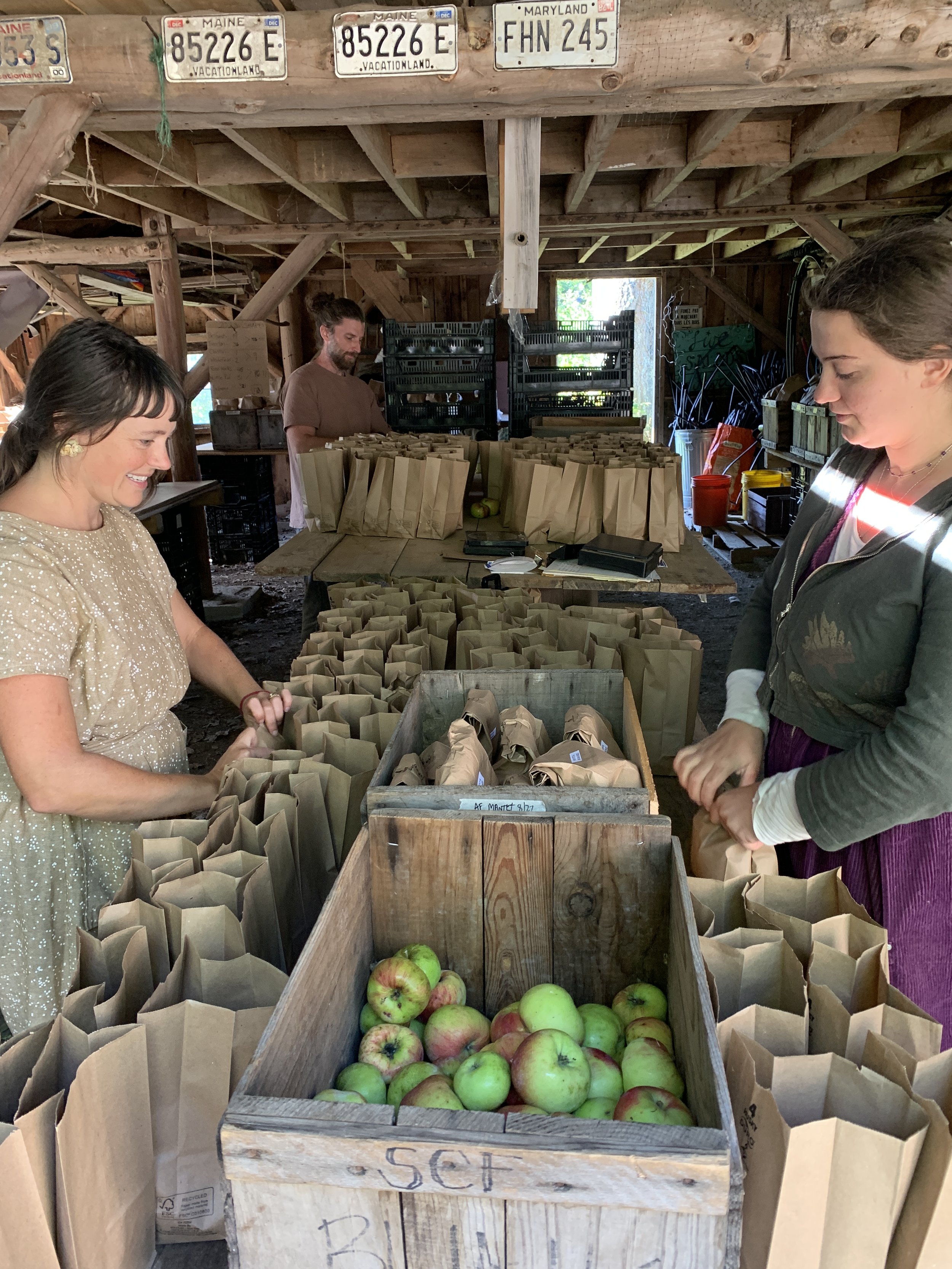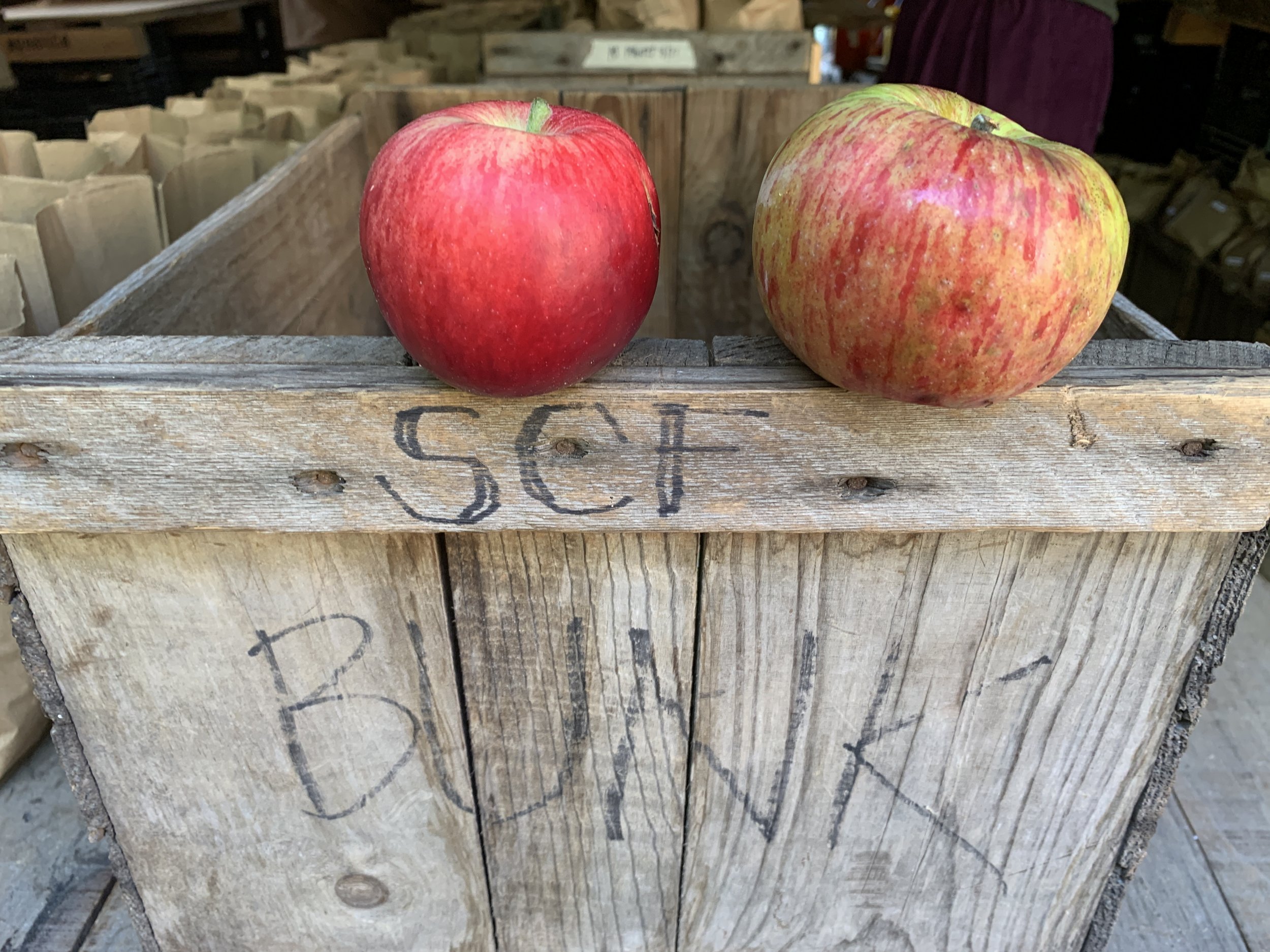I’ve grown vegetables every year since 1978. That was the year I purchased Jim Crockett’s book, The Victory Garden, joined the local community garden, and put my hands in the soil for the first time. The Victory Garden became my bible, and I never ventured onto my plot without it securely tucked under my arm. I looked to Jim for advice on seeding, watering, tending and harvesting. I worried all season that I was doing it wrong, but when I dug my first bushel of potatoes, I knew I was hooked for life.
Forty six years later I don’t angst so much over the garden. If it doesn’t rain, I can water or spread more mulch. If the flea beetles are bad, there’s agribon. An early frost? I close the sides of the hoop house. If the broccoli bolts, well, I prefer the side shoots anyway. But for all my ability to remain calm in the garden, I’m unable to find peace in the orchard. While tomato plants come and go, the trees are here for the long haul, and the long haul is different every season. Last year during the week the apple trees were in bloom the temperatures in our orchard dropped to 20 degrees. This year temperatures soared to 90 degrees. Three years ago we cut brown tail moth out of our trees for weeks during the winter. This year the web worms skeletonized trees in August. Did the abundant rain last year result in lower production this year or is it just the biennial nature of apples that is the cause? Will the temperatures stay so warm this fall that the trees can’t go into dormancy before winter? So many conditions out of our control means so many things to fret about. I have high hopes every spring when the trees burst into bloom. If we survive the bloom without a frost or heat wave, I anxiously look at the spent blossoms to see if the ovaries are swelling, the start of tiny apples. When the leaves come out, it’s difficult to see the new green fruit hidden in the leaves, and I experience another flush of anxiety that the trees have shed all their apples. Sometime in August the fruit begins to color up, and I breathe a sigh of relief, that is until I give the fruit a closer inspection for insect damage. And let’s not forget hail that can wipe out a crop in a matter of minutes.
So how did it turn out this year? Well, the hundred-year-old Milton and St. Lawrence trees in Fairfield and the similarly-aged Milwaukee tree in our Finley Lane orchard did not seem remotely concerned about too much heat or cold or rain or my angst or who's going to win in November. We tucked our ladders up through the branches of the ancient trees and picked bushel after bushel of magnificent fruit. Thank you to the trees and thanks to all of you for joining us once again in this annual plunge into the mystery of the orchard. Welcome! John & Cammy (who wrote this).
Picks of the week:
(Click each variety for more info)
Lizzie, Khris and Lily packing 164 bags of Mantet and Milwaukee for the CSA.
Sixteen years ago when we started Out on a Limb CSA, we branded it as a source of “Heirloom Apples”. Within a few years we had to admit that there were actually some tasty apples out there that weren’t historic varieties and that weren’t known by or readily available to the apple eating public. So we broadened the description of our CSA to be a promoter of “Rare and Unusual Apples”. With that in mind we introduce you to the first CSA share of 2024 that will take you time traveling through apple history from Europe in the 1500’s to modern day university breeding programs.
The elder of the group is the world famous Gravenstein. It is unclear whether it originated in Germany, Italy or Russia, but it made it’s way to North America across both the Atlantic and Pacific. Today it is honored in Maine for its prize-winning summer pies. In California people covet it as a hard cider component. Several years ago we visited an entire orchard of Gravenstein in Sonoma County that was grown for cider. The apples in your bag are Red Gravenstein, a “sport” of the original. The genetics are the same, but the skin appears a deeper red.
The second oldest apple in the group is the outrageously striped St. Lawrence. This fresh-eating apple originated in the 1800’s in Canada or the Northeastern US so we consider it a homegrown hero. One of its parents is the famous Fameuse, an old Canadian summer apple, but even DNA analysis hasn’t discovered its other parent. Leave the peel on if you add St. Lawrence to salads and cheese plates for maximum visual impact. It also makes good sauce.
The end of the 19th century added Milwaukee to our apple smorgasbord. It was discovered as a chance seedling on a farm in Wisconsin and was notable for being a good keeper, a rare quality in early season apples. Milwaukee is a seedling of the Aroostook County darling, Duchess, which has spawned many a similar offspring. This is the first time we have offered Milwaukee in the CSA; we have only one tree so we’re excited to be able to give you a taste, especially since the Duchess ripened too early this year to include. Use Milwaukee in pies and other baked goods, for sauce and in fresh cider.
Not long after Milwaukee was discovered, the NY State Experiment Station released another early season variety, Milton, that resulted from a cross between a Mac and the old summer variety, Yellow Transparent. This apple sports an array of colors - yellow, green, white, red and purple - as well as shapes that range from round to triangular. One of the most distinctive features is the filmy bloom that covers the skin and makes you think you’re looking at the apple on a foggy morning on the coast of Maine. Milton is good for fresh eating and cooks into a nice sauce.
The two relative newcomers to the apple world are Mantet and Zestar. The former is another Mac offspring, this time crossed with the old Russian variety, Tetofsky. Mantet is another newbie for the CSA. We had one tree of it that we had to cut down a few years ago. But we have topworked it to another tree which has enough of a crop to share this year. See what you think. We like Mantet. Zestar has more modern genetics - State Fair crossed with the odd-flavored, CSA- favorite Frostbite. Both are excellent dessert apples (meaning good for fresh eating), so BITE IN. Summer apples won’t wait.
Can you tell the difference between Mantet and Milwaukee? Put on your Sherlock Holmes hat, and see if you can figure out which is which.
Oh, I almost forgot. We packed the Milwaukee and the Mantet in the same bag giving you a chance to do a little apple identification. Use the links to the descriptions on our website - we think you will be able to tell which is which.
Our apples come to you straight from the tree, so, as with all fresh produce, please be sure to wash them thoroughly before eating. Some of the apples are grown using Integrated Pest Management by the orchards we collaborate with throughout Maine, and some are organically grown here on Super Chilly Farm.
Recipe of the Week
It has been such an amazing year for blackberries and blueberries that all my summer baking has been berry-filled. I thought about trying to sneak some apples into a Berry Cornmeal Tart that’s been my go to dessert of late, but this first share includes such a fabulous pie apple that really it deserved to take center stage in a solo performance. So pull out the Gravensteins, and give this a try.
I know I should have made a pie with these super pie apples, but I opted to go swimming instead of making a crust. That left only enough time for me to make an apple cake cooked in a pie plate (does that count as a pie?) before my friend, Mary, stopped by for a birthday dinner. I found this recipe in the NY Times by Florence Fabricant. There were lots of notes attached about the difficulty of removing the pie from the pan. No one seemed to think that just buttering the pie plate was adequate. I followed the advice of someone who suggested buttering the bottom of the pan, lining it with parchment paper and then buttering that. It worked fine but the underside of the cake wasn’t artistic or beautiful by any stretch of the imagination. On closer inspection I noticed that the picture in the Times was of a slice of the cake that hadn’t been turned upside down. Aha! I guess the food stylist had some trouble making it look nice too. So feel free to skip the upside-down direction and serve it as it comes out of the pan. If you do want to flip it and you flub it, you can always cover it up with some maple-laced whipped cream and no one will be the wiser.
Caramelized Apple-Pecan Cake (serves 8-10)
A few dollops of whipped cream will hide a lot of imperfections.
Ingredients:
1/4 cup pecan halves
2 large, tart apples, cored and sliced 1/4” thick
1 cup sugar
1/2 tsp salt
1/3 cup water
1/2 cup pecans
1/2 cup flour
3/4 tsp baking powder
1/2 tsp salt
8 TBS (1 stick) unsalted butter, softened
3/4 cup sugar
3 large eggs
1/2 tsp vanilla extract
Directions:
Grease a 10” glass pie plate. Sprinkle 1/4 cup of the pecan halves across the bottom. Arrange the apple slices on top. (The recipe suggests you spend time arranging these in a nice pattern, but once it cooks in the caramelized sugar, it was impossible to make out the pattern.)
Heat oven to 350 degrees.
Pulverize the remaining 1/2 cup of pecans in a food processor. Add flour, baking powder and 1/2 tsp salt, and pulse to mix.
Add 1 cup sugar, 1/2 tsp salt and 1/3 cup water to a skillet and mix. Place over medium-high heat, and cook until it turns amber-colored. Try to avoid stirring it, but you can swirl the pan if necessary. It may take a while for it to start to darken, but once it starts, it happens fast so don’t get distracted or it will burn. Once it has caramelized, pour it immediately over the apples. Don’t let it cool in the skillet.
Use a mixer to cream the butter and 3/4 cup sugar together. Beat in eggs one at a time followed by the vanilla. Fold in the flour mixture. Spread the batter over the apples. Bake 30 minutes until brown on the top.
Let the cake cool. Run a knife around the edges of the pan and invert onto a serving plate. Serve warm or cold with ice cream or whipped cream. (We thought it was even better after a night in the fridge.)




